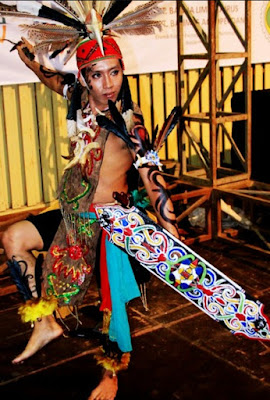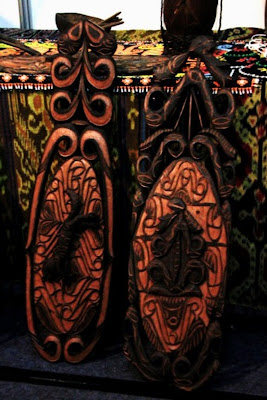"Talawang" In Mandau Dayak Dance
To complete the mandau, the Dayak people use a shield (shield or shield) in war. As with Mandau, talawang is a cultural object born of the Dayak community's belief in magical power. besides, the talisman also has an aesthetic side that is shown in the carving motif.
Talawang is made of ironwood or iron wood. But, there are also those made of clay wood. This type of wood is a staple that is often used in making talawang. the wood was chosen because in addition to being lightweight, it also can last up to hundreds of years.
Like the shield in general, the talang is rectangular which is made sharp at the top and bottom. The length of the talisman is around 1-2 meters with a maximum width of 50 centimeters. the outside of the talawang is decorated with carvings that characterize the Dayak culture, while the inside is given a handle.
That said, the engraving on the talisman has magical powers that are capable of arousing enthusiasm to make it strong for those who carry it. carving of talawang is generally motivated by tingang birds, which are considered sacred birds by the Dayak tribe. In addition to the tingang bird motif, another motif that is often used is kamang carving. Kamang is a manifestation of the spirit of the Dayak tribe ancestors. kamang motif is depicted by someone who is sitting using a loincloth and his face is red. Although each sub-tribe of the Dayak knows the culture of the mandau and talawang, it turns out that the use of colors and carving motifs on the talismans varies.
over time, the talisman has shifted the value of usability. If the talisman used to be used as the last defense in war, now talawang functions as a display object that is both aesthetically and economically valuable. one beautiful patterned talisman can be valued at hundreds to millions of rupiah. The price is comparable to the beauty of the motives offered by the makers. besides, along with mandau, talawang is also still used as a property in Dayak dance performances, such as mandau dance and pepatay dance.
Talawang is made of ironwood or iron wood. But, there are also those made of clay wood. This type of wood is a staple that is often used in making talawang. the wood was chosen because in addition to being lightweight, it also can last up to hundreds of years.
Like the shield in general, the talang is rectangular which is made sharp at the top and bottom. The length of the talisman is around 1-2 meters with a maximum width of 50 centimeters. the outside of the talawang is decorated with carvings that characterize the Dayak culture, while the inside is given a handle.
That said, the engraving on the talisman has magical powers that are capable of arousing enthusiasm to make it strong for those who carry it. carving of talawang is generally motivated by tingang birds, which are considered sacred birds by the Dayak tribe. In addition to the tingang bird motif, another motif that is often used is kamang carving. Kamang is a manifestation of the spirit of the Dayak tribe ancestors. kamang motif is depicted by someone who is sitting using a loincloth and his face is red. Although each sub-tribe of the Dayak knows the culture of the mandau and talawang, it turns out that the use of colors and carving motifs on the talismans varies.
over time, the talisman has shifted the value of usability. If the talisman used to be used as the last defense in war, now talawang functions as a display object that is both aesthetically and economically valuable. one beautiful patterned talisman can be valued at hundreds to millions of rupiah. The price is comparable to the beauty of the motives offered by the makers. besides, along with mandau, talawang is also still used as a property in Dayak dance performances, such as mandau dance and pepatay dance.

